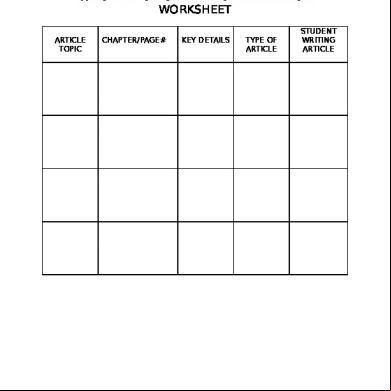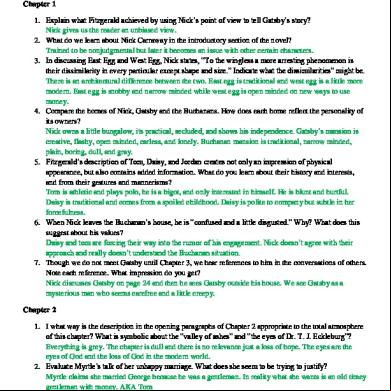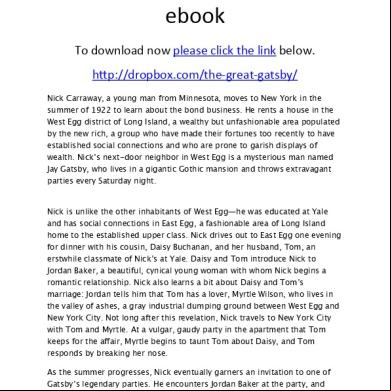The Great Gatsby Newspaper Article Worksheet 53365k
This document was ed by and they confirmed that they have the permission to share it. If you are author or own the copyright of this book, please report to us by using this report form. Report 3b7i
Overview 3e4r5l
& View The Great Gatsby Newspaper Article Worksheet as PDF for free.
More details w3441
- Words: 1,450
- Pages: 10
THE GREAT GATSBY NEWSPAPER ARTICLE WORKSHEET ARTICLE TOPIC
CHAPTER/PAGE#
KEY DETAILS
TYPE OF ARTICLE
STUDENT WRITING ARTICLE
The Great Gatsby Newspaper Assignment Sheet
While working in small groups, you will be creating a replica of a 1920’s newspaper highlighting key events from the book The Great Gatsby. Working collaboratively, your group will brainstorm ideas that can be transformed into either a news article, feature article, editorial, or any other article you may find in a newspaper. The topics for your articles should capture the key components of the book. Each of you will then draft, edit, and publish your article in your newspaper. Once published, each group will make a brief presentation to the class. Attached is the rubric that will be used in grading your project. Please pay careful attention to the requirements of the assignment. Be sure to include photos and images from the 1920’s to help create an air of authenticity to your project.
Newspaper : Great Gatsby Newspaper Article Teacher Name: Diane Blair Student Name:
CATEGORY
Layout Headlines & Captions
Articles ing Details
Who, What, When, Where & How
Graphics
Spelling and Proofreading
________________________________________
4
3
2
1
All articles have headlines that capture the reader\'s attention and accurately describe the content. All articles have a byline. All graphics have captions that adequately describe the people and action in the graphic.
All articles have headlines that accurately describe the content. All articles have a byline. All graphics have captions.
Most articles have headlines that accurately describe the content. All articles have a byline. Most graphics have captions.
Articles are missing bylines OR many articles do not have adequate headlines OR many graphics do not have captions.
The details in the articles are clear, effective, and vivid 90-100% of the time.
The details in the articles are clear and pertinent 80-89% of the time.
The details in the articles are clear and pertinent 70-79% of the time.
The details in more than 25% of the articles are neither clear nor pertinent.
All articles adequately address the 5 W\'s (who, what, when, where and how).
90-99% of the articles adequately address the 5 W\'s (who, what, when, where and how).
75-89% of the articles adequately address the 5 W\'s (who, what, when, where and how).
Less than 75% of the articles adequately address the 5 W\'s (who, what, when, where, and how).
Graphics are in focus, are wellcropped and are clearly related to the articles they accompany.
Graphics are in focus and are clearly related to the articles they accompany.
80-90% of the graphics are clearly related to the articles they accompany.
More than 20% of the graphics are not clearly related to the articles OR no graphics were used.
No spelling or grammar errors remain after one or more people (in addition to the typist) read and correct the newspaper.
No more than a couple of spelling or grammar errors remain after one or more people (in addition to the typist) read and correct the newspaper.
No more than 3 spelling or grammar errors remain after one or more people (in addition to the typist) read and correct the newspaper.
Several spelling or grammar errors remain in the final copy of the newspaper.
Name:____________________________ Date:______________
3-2-1 Worksheet Directions- While reviewing the F. Scott Fitzgerald Glogster and brief biography, please complete this 3-2-1 worksheet by filling in 3 facts that you have learned, 2 questions that you still have, and 1 personal connection that you can make to the information provided. Please ask if you have any questions or are unclear on what to do. 3 Facts you learned
2 Questions you still have
/1 Connection you can make
Fitzgerald’s Life
Jay Gatsby’s Life
Born in Mid-West (St. Paul, Minnesota) Tom and Nick attend Yale Nick and Gatsby serve in World War I Falls in love with Ginerva King , “Rich girls don’t marry poor boys”
Gatsby meets Daisy while stationed in Louisville, Kentucky. Too poor to marry her.
Daisy says “Hope she’ll be a beautiful little fool” at Pammy’s Birth
Makes money with first novel in order to marry Zelda
One daughter “Pammy” Nick lives in a “cottage” attends parties. Gatsby throws lavish parties
“wasted gift” to afford life style
Gatsby: Price paid for living his dream.
can be found in literature and poetry where the writing appeals to the senses. It can do this by giving a word with a specific meaning, by comparing two things in such a way that you find the comparison interesting or by using words that have unusual constructions or sounds. Figurative Language
Figurative Language: Understanding the Concept You are using figurative language when writing goes beyond the actual meanings of words so that the reader gains new insights into the objects or subjects in the work. One of the best ways to really understand the concept of figurative language is to see it in action such as with these examples:
Alright, the sky misses the sun at night. The poorest man is the richest, and the rich are poor. Hear the mellow wedding bells. - Edgar Allen Poe Out of reach, I pull out with a screech. I move fast like a cheetah on the Serengeti. Her head was spinning from all the new information. The toast jumped out of the toaster. I'm so hungry I could eat a horse. The Sea lashed out in anger at the ships, unwilling to tolerate another battle. The Redcoats are coming! I’ve told you a million times to clean your room!
Types of Figurative Language There are many types of figurative language. Some include the use of a specific type of word or word meaning such as:
Simile Metaphor Personification Symbolism
Figurative language can also include unusual constructions or combinations of words that give a new perspective on the word such as:
Alliteration Onomatopoeia Idiom
Following is an explanation of each type of figurative language, each with an example of figurative language: Simile A simile compares two things using the words “like” and “as.” Examples include:
busy as a bee clean as a whistle brave as a lion stand out like a sore thumb as easy as shooting fish in a barrel as dry as a bone as funny as a barrel of monkeys they fought like cats and dogs like watching grass grow
Metaphor When you use a metaphor, you make a statement that doesn’t make sense literally, like “time is a thief.” It only makes sense when the similarities between the two things become apparent or someone understands the connection. Examples include:
the world is my oyster you are a couch potato time is money he has a heart of stone America is a melting pot you are my sunshine
Personification Personification gives human characteristics to inanimate objects, animals, or ideas. This can really affect the way the reader imagines things. This is used in children’s books, poetry, and fictional literature. Examples include:
opportunity knocked on the door the sun greeted me this morning the sky was full of dancing stars the vines wove their fingers together to form a braid the radio stopped singing and stared at me the sun played hide and seek with the clouds
Symbolism Symbolism occurs when a word which has meaning in itself but is used to represent something entirely different. Examples are:
Using an image of the American flag to represent patriotism and a love for one’s country. Using an apple pie to represent an American lifestyle. Using an apple to represent education.
Alliteration Alliteration is the easiest of the examples of figurative language to spot. It is a repetition of the first consonant sounds in several words. Some good examples are:
wide-eyed and wondering while we wait for others to waken
And tongue twisters like:
Betty bought butter but the butter was bitter, so Betty bought better butter to make the bitter butter better.
Onomatopoeia Onomatopoeia is the use of words that sound like their meaning, or mimic sounds. They add a level of fun and reality to writing. Here are some examples:
the burning wood hissed and crackled
The words: beep, whirr, click, whoosh, swish, zap, zing, ping, clang, bong, hum, boom, munch, gobble, crunch, pow, smash, wham, quack, meow, oink, and tweet.
Idiom An idiom is an expression that has a meaning that is only known to a particular group of people. For example:
Kick the bucket Raining cats and dogs
Whistling Dixie
CHAPTER/PAGE#
KEY DETAILS
TYPE OF ARTICLE
STUDENT WRITING ARTICLE
The Great Gatsby Newspaper Assignment Sheet
While working in small groups, you will be creating a replica of a 1920’s newspaper highlighting key events from the book The Great Gatsby. Working collaboratively, your group will brainstorm ideas that can be transformed into either a news article, feature article, editorial, or any other article you may find in a newspaper. The topics for your articles should capture the key components of the book. Each of you will then draft, edit, and publish your article in your newspaper. Once published, each group will make a brief presentation to the class. Attached is the rubric that will be used in grading your project. Please pay careful attention to the requirements of the assignment. Be sure to include photos and images from the 1920’s to help create an air of authenticity to your project.
Newspaper : Great Gatsby Newspaper Article Teacher Name: Diane Blair Student Name:
CATEGORY
Layout Headlines & Captions
Articles ing Details
Who, What, When, Where & How
Graphics
Spelling and Proofreading
________________________________________
4
3
2
1
All articles have headlines that capture the reader\'s attention and accurately describe the content. All articles have a byline. All graphics have captions that adequately describe the people and action in the graphic.
All articles have headlines that accurately describe the content. All articles have a byline. All graphics have captions.
Most articles have headlines that accurately describe the content. All articles have a byline. Most graphics have captions.
Articles are missing bylines OR many articles do not have adequate headlines OR many graphics do not have captions.
The details in the articles are clear, effective, and vivid 90-100% of the time.
The details in the articles are clear and pertinent 80-89% of the time.
The details in the articles are clear and pertinent 70-79% of the time.
The details in more than 25% of the articles are neither clear nor pertinent.
All articles adequately address the 5 W\'s (who, what, when, where and how).
90-99% of the articles adequately address the 5 W\'s (who, what, when, where and how).
75-89% of the articles adequately address the 5 W\'s (who, what, when, where and how).
Less than 75% of the articles adequately address the 5 W\'s (who, what, when, where, and how).
Graphics are in focus, are wellcropped and are clearly related to the articles they accompany.
Graphics are in focus and are clearly related to the articles they accompany.
80-90% of the graphics are clearly related to the articles they accompany.
More than 20% of the graphics are not clearly related to the articles OR no graphics were used.
No spelling or grammar errors remain after one or more people (in addition to the typist) read and correct the newspaper.
No more than a couple of spelling or grammar errors remain after one or more people (in addition to the typist) read and correct the newspaper.
No more than 3 spelling or grammar errors remain after one or more people (in addition to the typist) read and correct the newspaper.
Several spelling or grammar errors remain in the final copy of the newspaper.
Name:____________________________ Date:______________
3-2-1 Worksheet Directions- While reviewing the F. Scott Fitzgerald Glogster and brief biography, please complete this 3-2-1 worksheet by filling in 3 facts that you have learned, 2 questions that you still have, and 1 personal connection that you can make to the information provided. Please ask if you have any questions or are unclear on what to do. 3 Facts you learned
2 Questions you still have
/1 Connection you can make
Fitzgerald’s Life
Jay Gatsby’s Life
Born in Mid-West (St. Paul, Minnesota) Tom and Nick attend Yale Nick and Gatsby serve in World War I Falls in love with Ginerva King , “Rich girls don’t marry poor boys”
Gatsby meets Daisy while stationed in Louisville, Kentucky. Too poor to marry her.
Daisy says “Hope she’ll be a beautiful little fool” at Pammy’s Birth
Makes money with first novel in order to marry Zelda
One daughter “Pammy” Nick lives in a “cottage” attends parties. Gatsby throws lavish parties
“wasted gift” to afford life style
Gatsby: Price paid for living his dream.
can be found in literature and poetry where the writing appeals to the senses. It can do this by giving a word with a specific meaning, by comparing two things in such a way that you find the comparison interesting or by using words that have unusual constructions or sounds. Figurative Language
Figurative Language: Understanding the Concept You are using figurative language when writing goes beyond the actual meanings of words so that the reader gains new insights into the objects or subjects in the work. One of the best ways to really understand the concept of figurative language is to see it in action such as with these examples:
Alright, the sky misses the sun at night. The poorest man is the richest, and the rich are poor. Hear the mellow wedding bells. - Edgar Allen Poe Out of reach, I pull out with a screech. I move fast like a cheetah on the Serengeti. Her head was spinning from all the new information. The toast jumped out of the toaster. I'm so hungry I could eat a horse. The Sea lashed out in anger at the ships, unwilling to tolerate another battle. The Redcoats are coming! I’ve told you a million times to clean your room!
Types of Figurative Language There are many types of figurative language. Some include the use of a specific type of word or word meaning such as:
Simile Metaphor Personification Symbolism
Figurative language can also include unusual constructions or combinations of words that give a new perspective on the word such as:
Alliteration Onomatopoeia Idiom
Following is an explanation of each type of figurative language, each with an example of figurative language: Simile A simile compares two things using the words “like” and “as.” Examples include:
busy as a bee clean as a whistle brave as a lion stand out like a sore thumb as easy as shooting fish in a barrel as dry as a bone as funny as a barrel of monkeys they fought like cats and dogs like watching grass grow
Metaphor When you use a metaphor, you make a statement that doesn’t make sense literally, like “time is a thief.” It only makes sense when the similarities between the two things become apparent or someone understands the connection. Examples include:
the world is my oyster you are a couch potato time is money he has a heart of stone America is a melting pot you are my sunshine
Personification Personification gives human characteristics to inanimate objects, animals, or ideas. This can really affect the way the reader imagines things. This is used in children’s books, poetry, and fictional literature. Examples include:
opportunity knocked on the door the sun greeted me this morning the sky was full of dancing stars the vines wove their fingers together to form a braid the radio stopped singing and stared at me the sun played hide and seek with the clouds
Symbolism Symbolism occurs when a word which has meaning in itself but is used to represent something entirely different. Examples are:
Using an image of the American flag to represent patriotism and a love for one’s country. Using an apple pie to represent an American lifestyle. Using an apple to represent education.
Alliteration Alliteration is the easiest of the examples of figurative language to spot. It is a repetition of the first consonant sounds in several words. Some good examples are:
wide-eyed and wondering while we wait for others to waken
And tongue twisters like:
Betty bought butter but the butter was bitter, so Betty bought better butter to make the bitter butter better.
Onomatopoeia Onomatopoeia is the use of words that sound like their meaning, or mimic sounds. They add a level of fun and reality to writing. Here are some examples:
the burning wood hissed and crackled
The words: beep, whirr, click, whoosh, swish, zap, zing, ping, clang, bong, hum, boom, munch, gobble, crunch, pow, smash, wham, quack, meow, oink, and tweet.
Idiom An idiom is an expression that has a meaning that is only known to a particular group of people. For example:
Kick the bucket Raining cats and dogs
Whistling Dixie





